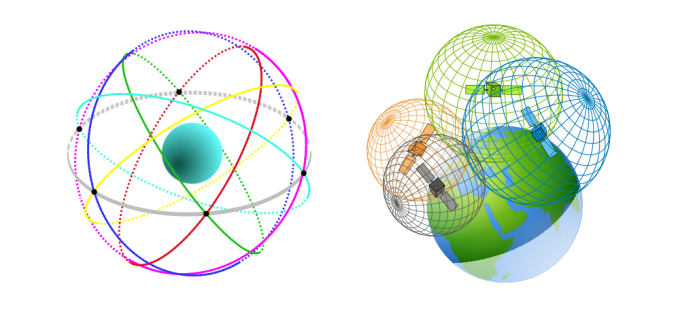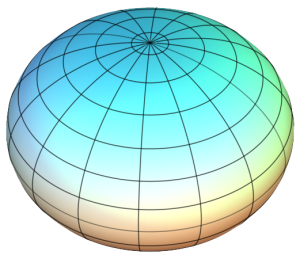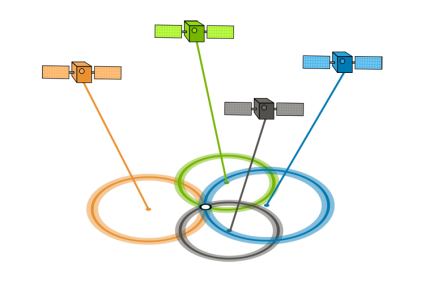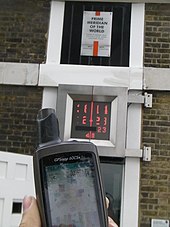You are here
Doc 9674 AN/946 — World Geodetic System — 1984 (WGS-84) Manual
The purpose of this manual is to furnish guidance on the\r\nprovision of geographic coordinates and vertical component values referenced to the WGS-84 datum in order to assist States in the uniform implementation of the SARPs on WGS-84
SKYbrary Partners:
Safety knowledge contributed by:
Join SKYbrary
If you wish to contribute or participate in the discussions about articles you are invited to join SKYbrary as a registered user
Contact us
About SKYbrary
From Wikipedia, the free encyclopedia
The World Geodetic System (WGS) is a standard used in cartography, geodesy, and satellite navigation including GPS. The current version, WGS 84, defines an Earth-centered, Earth-fixed coordinate system and a geodetic datum, and also describes the associated Earth Gravitational Model (EGM) and World Magnetic Model (WMM). The standard is published and maintained by the United States National Geospatial-Intelligence Agency.[1]
History[edit]
Efforts to supplement the various national surveying systems began in the 19th century with F.R. Helmert’s famous book Mathematische und Physikalische Theorien der Physikalischen Geodäsie (Mathematical and Physical Theories of Physical Geodesy). Austria and Germany founded the Zentralbüro für die Internationale Erdmessung (Central Bureau of International Geodesy), and a series of global ellipsoids of the Earth were derived (e.g., Helmert 1906, Hayford 1910/ 1924).
A unified geodetic system for the whole world became essential in the 1950s for several reasons:
- International space science and the beginning of astronautics.
- The lack of inter-continental geodetic information.
- The inability of the large geodetic systems, such as European Datum (ED50), North American Datum (NAD), and Tokyo Datum (TD), to provide a worldwide geo-data basis
- Need for global maps for navigation, aviation, and geography.
- Western Cold War preparedness necessitated a standardised, NATO-wide geospatial reference system, in accordance with the NATO Standardisation Agreement
WGS 60[edit]
In the late 1950s, the United States Department of Defense, together with scientists of other institutions and countries, began to develop the needed world system to which geodetic data could be referred and compatibility established between the coordinates of widely separated sites of interest. Efforts of the U.S. Army, Navy and Air Force were combined leading to the DoD World Geodetic System 1960 (WGS 60). The term datum as used here refers to a smooth surface somewhat arbitrarily defined as zero elevation, consistent with a set of surveyor’s measures of distances between various stations, and differences in elevation, all reduced to a grid of latitudes, longitudes, and elevations. Heritage surveying methods found elevation differences from a local horizontal determined by the spirit level, plumb line, or an equivalent device that depends on the local gravity field (see physical geodesy). As a result, the elevations in the data are referenced to the geoid, a surface that is not readily found using satellite geodesy. The latter observational method is more suitable for global mapping. Therefore, a motivation, and a substantial problem in the WGS and similar work is to patch together data that were not only made separately, for different regions, but to re-reference the elevations to an ellipsoid model rather than to the geoid.
In accomplishing WGS 60, a combination of available surface gravity data, astro-geodetic data and results from HIRAN[2] and Canadian SHORAN surveys were used to define a best-fitting ellipsoid and an earth-centered orientation for each of initially selected datum. (Every datum is relatively oriented with respect to different portions of the geoid by the astro-geodetic methods already described.) The sole contribution of satellite data to the development of WGS 60 was a value for the ellipsoid flattening which was obtained from the nodal motion of a satellite.
Prior to WGS 60, the U.S. Army and U.S. Air Force had each developed a world system by using different approaches to the gravimetric datum orientation method. To determine their gravimetric orientation parameters, the Air Force used the mean of the differences between the gravimetric and astro-geodetic deflections and geoid heights (undulations) at specifically selected stations in the areas of the major datums. The Army performed an adjustment to minimize the difference between astro-geodetic and gravimetric geoids. By matching the relative astro-geodetic geoids of the selected datums with an earth-centered gravimetric geoid, the selected datums were reduced to an earth-centered orientation. Since the Army and Air Force systems agreed remarkably well for the NAD, ED and TD areas, they were consolidated and became WGS 60.
WGS 66[edit]
Improvements to the global system included the Astrogeoid of Irene Fischer and the astronautic Mercury datum. In January 1966, a World Geodetic System Committee composed of representatives from the United States Army, Navy and Air Force was charged with developing an improved WGS, needed to satisfy mapping, charting and geodetic requirements. Additional surface gravity observations, results from the extension of triangulation and trilateration networks, and large amounts of Doppler and optical satellite data had become available since the development of WGS 60. Using the additional data and improved techniques, WGS 66 was produced which served DoD needs for about five years after its implementation in 1967. The defining parameters of the WGS 66 Ellipsoid were the flattening (1/298.25 determined from satellite data) and the semimajor axis (6378145 m determined from a combination of Doppler satellite and astro-geodetic data). A worldwide 5° × 5° mean free air gravity anomaly field provided the basic data for producing the WGS 66 gravimetric geoid. Also, a geoid referenced to the WGS 66 Ellipsoid was derived from available astrogeodetic data to provide a detailed representation of limited land areas.
WGS 72[edit]
After an extensive effort over a period of approximately three years, the Department of Defense World Geodetic System 1972 was completed. Selected satellite, surface gravity and astrogeodetic data available through 1972 from both DoD and non-DoD sources were used in a Unified WGS Solution (a large scale least squares adjustment). The results of the adjustment consisted of corrections to initial station coordinates and coefficients of the gravitational field.
The largest collection of data ever used for WGS purposes was assembled, processed and applied in the development of WGS 72. Both optical and electronic satellite data were used. The electronic satellite data consisted, in part, of Doppler data provided by the U.S. Navy and cooperating non-DoD satellite tracking stations established in support of the Navy’s Navigational Satellite System (NNSS). Doppler data was also available from the numerous sites established by GEOCEIVERS during 1971 and 1972. Doppler data was the primary data source for WGS 72 (see image). Additional electronic satellite data was provided by the SECOR (Sequential Collation of Range) Equatorial Network completed by the U.S. Army in 1970. Optical satellite data from the Worldwide Geometric Satellite Triangulation Program was provided by the BC-4 camera system (see image). Data from the Smithsonian Astrophysical Observatory was also used which included camera (Baker–Nunn) and some laser ranging.
The surface gravity field used in the Unified WGS Solution consisted of a set of 410 10° × 10° equal area mean free air gravity anomalies determined solely from terrestrial data. This gravity field includes mean anomaly values compiled directly from observed gravity data wherever the latter was available in sufficient quantity. The value for areas of sparse or no observational data were developed from geophysically compatible gravity approximations using gravity-geophysical correlation techniques. Approximately 45 percent of the 410 mean free air gravity anomaly values were determined directly from observed gravity data.
The astrogeodetic data in its basic form consists of deflection of the vertical components referred to the various national geodetic datums. These deflection values were integrated into astrogeodetic geoid charts referred to these national datums. The geoid heights contributed to the Unified WGS Solution by providing additional and more detailed data for land areas. Conventional ground survey data was included in the solution to enforce a consistent adjustment of the coordinates of neighboring observation sites of the BC-4, SECOR, Doppler and Baker–Nunn systems. Also, eight geodimeter long line precise traverses were included for the purpose of controlling the scale of the solution.
The Unified WGS Solution, as stated above, was a solution for geodetic positions and associated parameters of the gravitational field based on an optimum combination of available data. The WGS 72 ellipsoid parameters, datum shifts and other associated constants were derived separately. For the unified solution, a normal equation matrix was formed based on each of the mentioned data sets. Then, the individual normal equation matrices were combined and the resultant matrix solved to obtain the positions and the parameters.
The value for the semimajor axis (a) of the WGS 72 Ellipsoid is 6378135 m. The adoption of an a-value 10 meters smaller than that for the WGS 66 Ellipsoid was based on several calculations and indicators including a combination of satellite and surface gravity data for position and gravitational field determinations. Sets of satellite derived station coordinates and gravimetric deflection of the vertical and geoid height data were used to determine local-to-geocentric datum shifts, datum rotation parameters, a datum scale parameter and a value for the semimajor axis of the WGS Ellipsoid. Eight solutions were made with the various sets of input data, both from an investigative point of view and also because of the limited number of unknowns which could be solved for in any individual solution due to computer limitations. Selected Doppler satellite tracking and astro-geodetic datum orientation stations were included in the various solutions. Based on these results and other related studies accomplished by the committee, an a-value of 6378135 m and a flattening of 1/298.26 were adopted.
In the development of local-to WGS 72 datum shifts, results from different geodetic disciplines were investigated, analyzed and compared. Those shifts adopted were based primarily on a large number of Doppler TRANET and GEOCEIVER station coordinates which were available worldwide. These coordinates had been determined using the Doppler point positioning method.
WGS 84[edit]
In the early 1980s, the need for a new world geodetic system was generally recognized by the geodetic community as well as within the US Department of Defense. WGS 72 no longer provided sufficient data, information, geographic coverage, or product accuracy for all then-current and anticipated applications. The means for producing a new WGS were available in the form of improved data, increased data coverage, new data types and improved techniques. Observations from Doppler, satellite laser ranging and very-long-baseline interferometry (VLBI) constituted significant new information. An outstanding new source of data had become available from satellite radar altimetry. Also available was an advanced least squares method called collocation that allowed for a consistent combination solution from different types of measurements all relative to the Earth’s gravity field, measurements such as the geoid, gravity anomalies, deflections, and dynamic Doppler.
The new world geodetic system was called WGS 84. It is the reference system used by the Global Positioning System. It is geocentric and globally consistent within 1 m. Current geodetic realizations of the geocentric reference system family International Terrestrial Reference System (ITRS) maintained by the IERS are geocentric, and internally consistent, at the few-cm level, while still being metre-level consistent with WGS 84.
The WGS 84 reference ellipsoid was based on GRS 80, but it contains a very slight variation in the inverse flattening, as it was derived independently and the result was rounded to a different number of significant digits.[3] This resulted in a tiny difference of 0.105 mm in the semi-minor axis.[4]
The following table compares the primary ellipsoid parameters.
| Ellipsoid reference | Semi-major axis a | Semi-minor axis b | Inverse flattening 1/f |
|---|---|---|---|
| GRS 80 | 6378137.0 m | ≈ 6356752.314140 m | 298.257222100882711… |
| WGS 84[5] | 6378137.0 m | ≈ 6356752.314245 m | 298.257223563 |
Definition[edit]
The coordinate origin of WGS 84 is meant to be located at the Earth’s center of mass; the uncertainty is believed to be less than 2 cm.[6]
The WGS 84 meridian of zero longitude is the IERS Reference Meridian,[7] 5.3 arc seconds or 102 metres (335 ft) east of the Greenwich meridian at the latitude of the Royal Observatory.[8][9] (This is related to the fact that the local gravity field at Greenwich does not point exactly through the Earth’s center of mass, but rather «misses west» of the center of mass by about 102 meters.) The longitude positions on WGS 84 agree with those on the older North American Datum 1927 at roughly 85° longitude west, in the east-central United States.
The WGS 84 datum surface is an oblate spheroid with equatorial radius a = 6378137 m at the equator and flattening f = 1/298.257223563. The refined value of the WGS 84 gravitational constant (mass of Earth’s atmosphere included) is GM = 3.986004418×1014 m3/s2. The angular velocity of the Earth is defined to be ω = 72.92115×10−6 rad/s.[10]
This leads to several computed parameters such as the polar semi-minor axis b which equals a × (1 − f) = 6356752.3142 m, and the first eccentricity squared, e2 = 6.69437999014×10−3.[10]
Updates and new standards[edit]
The original standardization document for WGS 84 was Technical Report 8350.2, published in September 1987 by the Defense Mapping Agency (which later became the National Imagery and Mapping Agency). New editions were published in September 1991 and July 1997; the latter edition was amended twice, in January 2000 and June 2004.[11] The standardization document was revised again and published in July 2014 by the National Geospatial-Intelligence Agency as NGA.STND.0036.[12] These updates provide refined descriptions of the Earth and realizations of the system for higher precision.
WGS 84 has most recently been updated to use the reference frame G2139, which was released on January 3, 2021 as an update to G1762′ (with a prime).[13] This frame is aligned with the IGb14 realization of the International Terrestrial Reference Frame (ITRF) 2014 and uses the new IGS Antex standard.[14][13]
Updates to the original geoid for WGS 84 are now published as a separate Earth Gravitational Model (EGM), with improved resolution and accuracy. Likewise, the World Magnetic Model (WMM) is updated separately. The current version of WGS 84 uses EGM2008 and WMM2020.[15][16]
Solution for Earth orientation parameters consistent with ITRF2014 is also needed (IERS EOP 14C04).[17]
Identifiers[edit]
Components of WGS 84 are identified by codes in the EPSG Geodetic Parameter Dataset:[18]
- EPSG:4326 – 2D coordinate reference system (CRS)
- EPSG:4979 – 3D CRS
- EPSG:4978 – geocentric 3D CRS
- EPSG:7030 – reference ellipsoid
- EPSG:6326 – horizontal datum
See also[edit]
- Degree Confluence Project
- Earth Gravitational Model
- European Terrestrial Reference System 1989
- Geo (microformat) – for marking up WGS 84 coordinates in (X)HTML
- geo URI scheme
- Geographic information system
- Geotagging
- GIS file formats
- North American Datum
- Point of interest
- TRANSIT system
References[edit]
- ^ «World Geodetic System 1984 (WGS 84)». Office of Geomatics, National Geospatial-Intelligence Agency. Retrieved 2022-12-21.
- ^ «NOAA History — Stories and Tales of the Coast & Geodetic Survey — Personal Tales/Earth Measurer/Aslakson Bio». History.noaa.gov. Retrieved 2017-05-24.
- ^ Hooijberg, Maarten (2007-12-18). Geometrical Geodesy: Using Information and Computer Technology. Germany: Springer Berlin Heidelberg. p. 20. ISBN 9783540682257.
- ^ «USER DOCUMENTATION Programs: INVERSE, FORWARD, INVERS3D, FORWRD3D Versions 2.0». geodesy.noaa.gov. Retrieved 2022-05-23.
- ^ «WGS 84: Ellipsoid Details». EPSG Geodetic Parameter Dataset. Retrieved 2022-12-21.
- ^ «The EGM96 Geoid Undulation with Respect to the WGS84 Ellipsoid». NASA.
- ^ European Organisation for the Safety of Air Navigation and IfEN: WGS 84 Implementation Manual, p. 13. 1998
- ^ «Greenwich Meridan, Tracing its History». Gpsinformation.net. Retrieved 2017-05-24.
- ^ Malys, Stephen; Seago, John H.; Palvis, Nikolaos K.; Seidelmann, P. Kenneth; Kaplan, George H. (1 August 2015). «Why the Greenwich meridian moved». Journal of Geodesy. 89 (12): 1263–1272. Bibcode:2015JGeod..89.1263M. doi:10.1007/s00190-015-0844-y.
- ^ a b «Department of Defense World Geodetic System 1984» (PDF) (2nd ed.). Defense Mapping Agency. 1991-09-01. Archived (PDF) from the original on August 3, 2021.
- ^ «DMA TR 8350.2 WGS». IHS Markit Standards Store. Retrieved 2022-12-26.
- ^ «Data collection of WGS 84 information — or is it?». GPS World. 2 November 2016.
- ^ a b «(U) Recent Update to WGS 84 Reference Frame and NGA Transition to IGS ANTEX» (PDF). Retrieved 2023-01-15.
{{cite web}}: CS1 maint: url-status (link) - ^ Australian Government — Geoscience Australia (2017-03-20). «What are the limitations of using World Geodetic System 1984 in Australia?». www.ga.gov.au. Retrieved 2022-05-16.
- ^ «NGA Geomatics — WGS 84». earth-info.nga.mil. Retrieved 2019-03-19.
- ^ «World Magnetic Model». NCEI. Retrieved 2020-01-23.
- ^ «Evolution of the World Geodetic System 1984 (WGS 84) Terrestrial Reference Frame» (PDF). Retrieved 2023-01-15.
- ^ «World Geodetic System 1984 ensemble». EPSG Geodetic Parameter Dataset. Retrieved 2022-12-21.
This article incorporates public domain material from websites or documents of the National Geodetic Survey.
External links[edit]
- NGA Standardization Document Department of Defense World Geodetic System 1984, Its Definition and Relationships With Local Geodetic Systems (2014-07-08)
- DMA Technical Report 8350.2 Department of Defense World Geodetic System 1984, Its Definition and Relationships With Local Geodetic Systems (1991-09-01). This edition documents the original Earth Gravitational Model.
- NGA webpage for WGS 84
- Geodesy for the Layman, Chapter VIII, «The World Geodetic System»
- Spatial reference for EPSG:4326
- ANTEX (.atx) files that define IGS20

WGS84 is standard for GPS
The Global Positioning System uses the World Geodetic System (WGS84) as its reference coordinate system.
It consists of a reference ellipsoid, a standard coordinate system, altitude data, and a geoid.
Similar to the North American Datum of 1983 (NAD83), it uses the Earth’s center mass as the coordinate origin.
Geodesists believe the error is less than 2 centimeters which is better than NAD83.
Pinpoint Your Position Using WGS84
When you need to accurately enter coordinates in a GIS, the first step is to uniquely define all coordinates on Earth.
This means you need a reference frame for your latitude and longitude coordinates because where would you be on Earth without having a reference to it?
Because the Earth is curved – and in GIS we deal with flat map projections – we need to accommodate both the curved and flat views of the world. Surveyors and geodesists have accurately defined locations on Earth.

We begin modeling the Earth with an ellipsoid. To be clear, this is different from a geoid which is a measure of mean sea level. Over time, the ellipsoid has been estimated to the best of our ability through a massive collection of surface measurements.
When you combine these measurements, we arrive at a geodetic datum. Horizontal datums precisely specify each location on Earth’s surface in latitude and longitude or other coordinate systems. For instance, NAD27, NAD83, and WGS84 are examples of geodetic datums.
Using geographic coordinate systems, we can define positions on Earth. For example, we use degrees/minutes/seconds (DMS) and decimal degrees (DD) for spherical coordinates.
After we flatten the Earth with map projections, we use projected coordinate systems like the State Plane Coordinate System (SPCS) or UTM grid system.
WGS84: Unifying a Global Ellipsoid Model with GPS
It wasn’t until the mainstream use of Global Positioning Systems (GPS) that geodesists first developed a unified global ellipsoid model.
The radio waves transmitted by GPS satellites and trilateration enable extremely precise Earth measurements across continents and oceans. Geodesists could create global ellipsoid models because of the enhancement of computing capabilities and GPS technology.

This led to the development of global ellipsoid models such as WGS72, GRS80, and WGS84 (current). The Global Positioning System uses the World Geodetic System (WGS84) as its reference coordinate system.
What is EPSG4326? EPSG4326 is just the way to identify WGS84 using EPSG.
It’s important to note that while WGS84 serves as a global reference, various regional geodetic datums might be more accurate for specific areas. In such cases, coordinate transformations are used to convert between different datums and the WGS84 reference frame.
Summary: World Geodetic System (WGS84)
Never before have we been able to estimate the ellipsoid with such precision.
This is primarily because of the global set of measurements provided by GPS.
WGS84 consists of a reference ellipsoid, a standard coordinate system, altitude data, and a geoid.
The error of WGS84 is believed to be less than 2 centimeters to the center mass.








